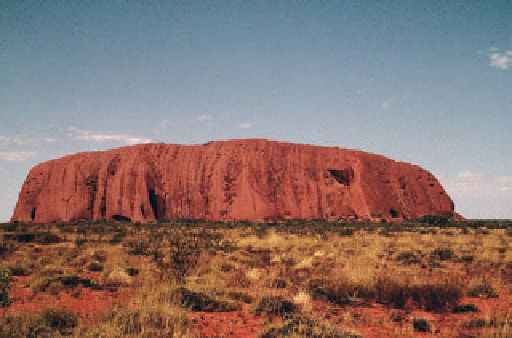Geography Reference
In-Depth Information
Field Note
“Arriving at the foot of erosion-carved Uluru just before sun-
rise it is no surprise that this giant monolith, towering over
the Australian desert, is a sacred place to local Aboriginal
peoples. Throughout the day, the changing sun angle alters
its colors until, toward sunset, it turns a fi ery red that yields
to a bright orange. At night it looms against the moonlit,
starry sky, silent sentinel of the gods. Just two years before
this, my fi rst visit in 1987, the Australian government had
returned “Ayers Rock” (named by European settlers after a
South Australian political leader) to Aboriginal ownership,
and reclaimed its original name, Uluru. Visitors continued
to be allowed to climb the 1100 feet (335m) to the top, from
where the view over the desert is awesome.
My day had begun eventfully when a three-foot liz-
ard emerged from under my motel-room bed, but the
chain-assisted climb was no minor challenge either. At
the base you are warned to be “in good shape” and some
would-be climbers don't make it, but the rewards of per-
sisting are dramatic. Uluru's iron-rich sandstone strata have
been sculpted into gullies and caves, the latter containing
Aboriginal carvings and paintings, and on the broad summit
there are plenty of places where you can sit quietly to con-
template the historic, religious, and cultural signifi cance of
a place that mattered thousands of years before globaliza-
tion reached Australia.”
Figure 7.18
Uluru, Australia.
© H. J. de Blij.
over 6 billion. Hundreds of millions of peoples are not
counted in this fi gure because they practice traditional
religions. But even when they are taken into account,
additional hundreds of millions do not practice a reli-
gion at all. Moreover, even church membership fi gures
do not accurately refl ect the number of
active members
of a church. When polled about their church-going
activities, fewer than 3 percent of the people in
Scandinavia reported frequent attendance, and in
France and Great Britain, less than 10 percent reported
attending church at least once a month. The lack of
members active or otherwise underscores the rise of
secularism—indifference to or rejection of organized
religious affiliations and ideas.
The level of secularism throughout much of the
Christian and Buddhist worlds varies from country
to country and regionally within countries. In North
America, for instance, a poll in 2002 asked whether people
felt religion was very important to them. Only 30 per-
cent of Canadians agreed with this statement, whereas
59 percent of Americans felt religion was very important
to them. In France, the government recently banned the
wearing of overt religious symbols in public schools. The
French government wanted to remove the “disruption”
of Muslim girls wearing hijab (head scarves), Jewish boys
wearing yarmulke (skullcaps), and Christian students
wearing large crosses to school. The French government
took the position that banning all religious symbols was
the only egalitarian approach.
Looking at polls that ask about the importance of
religion for people in a country does not give us the com-
plete picture, however. Canada's 30 percent rate would
be much, much lower if we removed recent or second-
generation immigrants from the tally. Immigrants often
hold onto their religion more fervently in part to help
them ease into a new place and to link into a community
in their new home. Buddhists and Hindus on Canada's
west coast and Muslims in the eastern part of Canada
have a higher rate of adherence to their religion than
many long-term residents of the country.













































